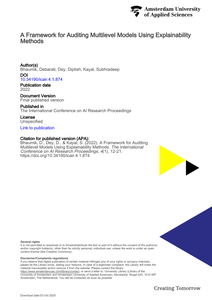This paper examines the network governance approach of the Dutch Urban Envoy in the context of multilevel governance in the European Union. This paper aims to answer the research question on how the scope of network governance can explore the performance of the Dutch Urban Envoy. By analyzing network characteristics, such as legitimacy, actor-level properties, and network-level properties, this paper seeks to provide a nuanced understanding of the performance of the Dutch Urban Envoy. Drawing on previous research, this paper identifies the applicability and limitations of assessing network characteristics in understanding advocacy processes. The paper successfully visualizes the networks of the Dutch Urban Envoy and explores their roles and mandates, contributing to determining the added value of their position. However, the network governance approach has limitations in explaining the tangible successes and challenges of the Dutch Urban Envoy that cannot be directly attributed to their overall performance.
MULTIFILE

The article engages with the recent studies on multilevel regulation. The starting point for the argument is that contemporary multilevel regulation—as most other studies of (postnational) rulemaking—is limited in its analysis. The limitation concerns its monocentric approach that, in turn, deepens the social illegitimacy of contemporary multilevel regulation. The monocentric approach means that the study of multilevel regulation originates in the discussions on the foundation of modern States instead of returning to the origins of rules before the nation State was even created, which is where the actual social capital underlying (contemporary) rules can be found, or so I wish to argue. My aim in this article is to reframe the debate. I argue that we have an enormous reservoir of history, practices, and ideas ready to help us think through contemporary (social) legitimacy problems in multilevel regulation: namely all those practices which preceded the capture of law by the modern State system, such as historical alternative dispute resolution (ADR) practices.
DOCUMENT

Multilevel models (MLMs) are increasingly deployed in industry across different functions. Applications usually result in binary classification within groups or hierarchies based on a set of input features. For transparent and ethical applications of such models, sound audit frameworks need to be developed. In this paper, an audit framework for technical assessment of regression MLMs is proposed. The focus is on three aspects: model, discrimination, and transparency & explainability. These aspects are subsequently divided into sub-aspects. Contributors, such as inter MLM-group fairness, feature contribution order, and aggregated feature contribution, are identified for each of these sub-aspects. To measure the performance of the contributors, the framework proposes a shortlist of KPIs, among others, intergroup individual fairness (DiffInd_MLM) across MLM-groups, probability unexplained (PUX) and percentage of incorrect feature signs (POIFS). A traffic light risk assessment method is furthermore coupled to these KPIs. For assessing transparency & explainability, different explainability methods (SHAP and LIME) are used, which are compared with a model intrinsic method using quantitative methods and machine learning modelling.Using an open-source dataset, a model is trained and tested and the KPIs are computed. It is demonstrated that popular explainability methods, such as SHAP and LIME, underperform in accuracy when interpreting these models. They fail to predict the order of feature importance, the magnitudes, and occasionally even the nature of the feature contribution (negative versus positive contribution on the outcome). For other contributors, such as group fairness and their associated KPIs, similar analysis and calculations have been performed with the aim of adding profundity to the proposed audit framework. The framework is expected to assist regulatory bodies in performing conformity assessments of AI systems using multilevel binomial classification models at businesses. It will also benefit providers, users, and assessment bodies, as defined in the European Commission’s proposed Regulation on Artificial Intelligence, when deploying AI-systems such as MLMs, to be future-proof and aligned with the regulation.
DOCUMENT

City Deal Nijmegen wil een versnelling tot stand brengen in het oplossen van maatschappelijke opgaven van de stad door onderzoekers, docenten en studenten hierbij grootschalig te betrekken. De Hogeschool van Arnhem en Nijmegen, de Radboud Universiteit en de gemeente Nijmegen hebben zich vanaf 2017 tot doel gesteld om (vaak al bestaande) samenwerking te verduurzamen door het beter ontsluiten en verbinden van succesvolle initiatieven waardoor er een rijke leeromgeving voor studenten kan ontstaan. Onze ambitie is dat over tien jaar een instrumentarium beschikbaar is waarmee kennisinstellingen en gemeente via een interdisciplinaire en multilevel aanpak, in gezamenlijkheid werken aan (grote) maatschappelijke thema’s. De belangrijkste uitdagingen voor de komende twee jaar zijn: 1. Meer interdisciplinair en multilevel maken van onderwijsprojecten 2. Deze projecten op een duurzame en longitudinale manier inbedden in het reguliere onderwijs. Om deze uitdagingen het hoofd te bieden, investeren wij de komende twee jaar op twee manieren in een toekomstbestendige en logische infrastructuur binnen de inhoudelijke thema’s zoals deze zijn vastgesteld in de strategische agenda: 1. Wij investeren in onderwijsinnovatie via een impulsfinanciering; bestaande succesvolle onderwijsprojecten worden verder verspreid over de stad Nijmegen, projecten worden méér interdisciplinair en mulitlevel, projecten worden bij meer opleidingen steviger ingebed in het onderwijs. 2. Wij investeren in netwerk governance; kennisdeling, verbinding, communicatie en onderzoek zijn essentieel bij het opbouwen van een werkend en succesvol instrumentarium.